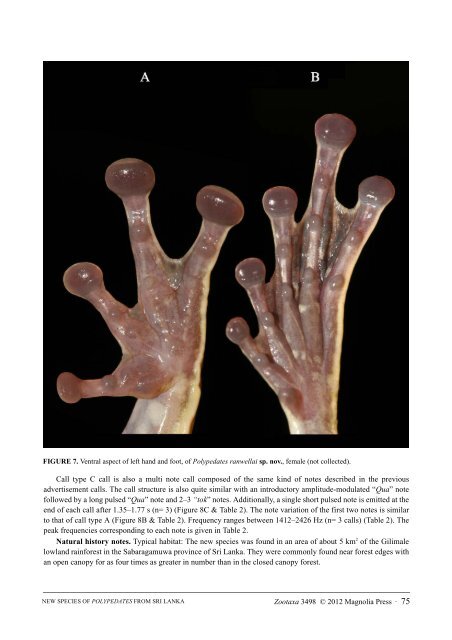A New Species of Polypedates Tschudi
A new species of frog tentatively assigned to the genus Polypedates is described from the Gilimale forest reserve of the Sabaragamuwa province of Sri Lanka. This tree frog is characterized by unique osteological characteristics in the skull which distinguish it from all other congeners, such as the presence of a series of maxillary teeth progressively changing orientation from horizontal to vertical from …
A new species of frog tentatively assigned to the genus Polypedates is described from the Gilimale forest reserve of the Sabaragamuwa province of Sri Lanka. This tree frog is characterized by unique osteological characteristics in the skull which distinguish it from all other congeners, such as the presence of a series of maxillary teeth progressively changing orientation from horizontal to vertical from …
You also want an ePaper? Increase the reach of your titles
YUMPU automatically turns print PDFs into web optimized ePapers that Google loves.
TERMS OF USE<br />
This pdf is provided by Magnolia Press for private/research use.<br />
Commercial sale or deposition in a public library or website is prohibited.<br />
FIGURE 7. Ventral aspect <strong>of</strong> left hand and foot, <strong>of</strong> <strong>Polypedates</strong> ranwellai sp. nov., female (not collected).<br />
Call type C call is also a multi note call composed <strong>of</strong> the same kind <strong>of</strong> notes described in the previous<br />
advertisement calls. The call structure is also quite similar with an introductory amplitude-modulated “Qua” note<br />
followed by a long pulsed “Qua” note and 2–3 “tok” notes. Additionally, a single short pulsed note is emitted at the<br />
end <strong>of</strong> each call after 1.35–1.77 s (n= 3) (Figure 8C & Table 2). The note variation <strong>of</strong> the first two notes is similar<br />
to that <strong>of</strong> call type A (Figure 8B & Table 2). Frequency ranges between 1412–2426 Hz (n= 3 calls) (Table 2). The<br />
peak frequencies corresponding to each note is given in Table 2.<br />
Natural history notes. Typical habitat: The new species was found in an area <strong>of</strong> about 5 km 2 <strong>of</strong> the Gilimale<br />
lowland rainforest in the Sabaragamuwa province <strong>of</strong> Sri Lanka. They were commonly found near forest edges with<br />
an open canopy for as four times as greater in number than in the closed canopy forest.<br />
NEW SPECIES OF POLYPEDATES FROM SRI LANKA<br />
Zootaxa 3498 © 2012 Magnolia Press · 75















